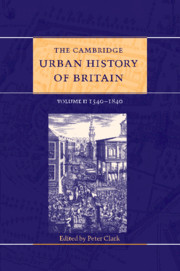Book contents
- Frontmatter
- 1 Introduction
- Part I Area surveys 1540–1840
- Introduction
- 2(a) England: East Anglia
- 2(b) England: South-East
- 2(c) England: South-West
- 2(d) England: Midlands
- 2(e) England: North
- 3 Wales
- 4 Scotland
- Part II Urban themes and types 1540–1700
- Part III Urban themes and types 1700–1840
- Select Bibliography
- Index
- References
2(d) - England: Midlands
from Part I - Area surveys 1540–1840
Published online by Cambridge University Press: 28 March 2008
- Frontmatter
- 1 Introduction
- Part I Area surveys 1540–1840
- Introduction
- 2(a) England: East Anglia
- 2(b) England: South-East
- 2(c) England: South-West
- 2(d) England: Midlands
- 2(e) England: North
- 3 Wales
- 4 Scotland
- Part II Urban themes and types 1540–1700
- Part III Urban themes and types 1700–1840
- Select Bibliography
- Index
- References
Summary
the historical Midlands is a concept which is difficult to pin down; to some extent it amounts to that area which is left when more distinctive provincial blocks are removed. For the purposes of this volume the Midlands is defined as the West Midland counties of Herefordshire and Shropshire, Worcestershire and Warwickshire, combined with the East Midland shires of Derby, Leicester and Rutland, Northampton, Nottingham and Lincoln. There do exist some natural features which help to define this region: uplands to the west and north and the Lincolnshire seacoast, but the southern border can only be defined in our period in terms of the weakening fringe of London’s primary commercial region. This is shown by analysis of the bases of Londonbound carriers in 1684 where there is a marked reduction at about a ninety mile radius from the capital, leaving Worcestershire, mid Warwickshire and mid Leicestershire outside, but Northamptonshire within, London’s region. It is no surprise to find that the major Midland towns all lie beyond this frontier.
Yet the urban networks of the Midlands do have a self-contained and consistent character which justifies thinking in these terms. While the Midland towns by their very location had vital external links, most of them looked primarily to London or to other towns within the region. And they had a great deal in common, for much of the region suffered from poor communications in the sixteenth and seventeenth centuries, and it was a truism of contemporary thought that distance from navigable water necessarily discouraged economic growth: thus in 1722 it was said of Leicestershire that ‘being the most inland county in England, and consequently far from any sea or navigable rivers, you must not suppose it a county of any trade’.
- Type
- Chapter
- Information
- The Cambridge Urban History of Britain , pp. 93 - 110Publisher: Cambridge University PressPrint publication year: 2000
References
- 2
- Cited by



